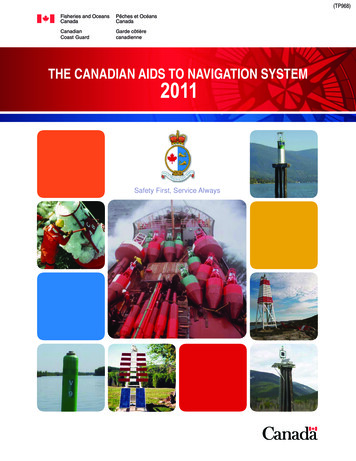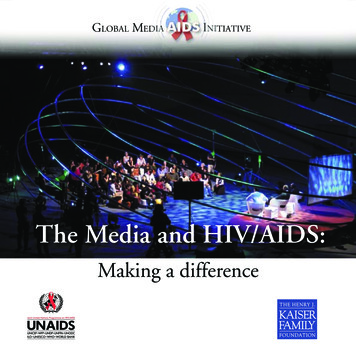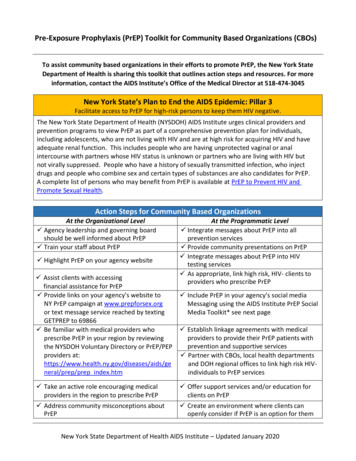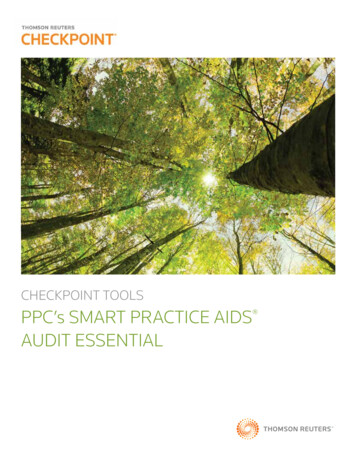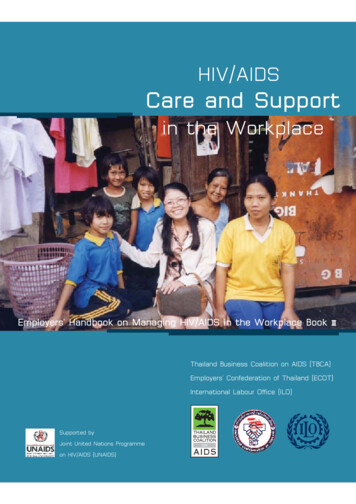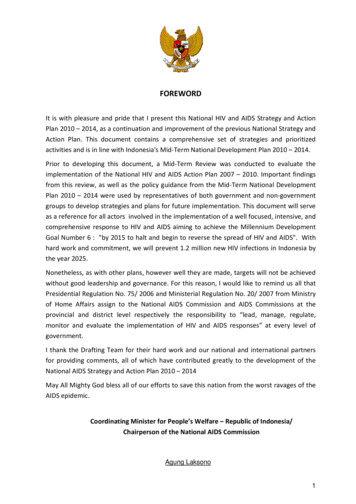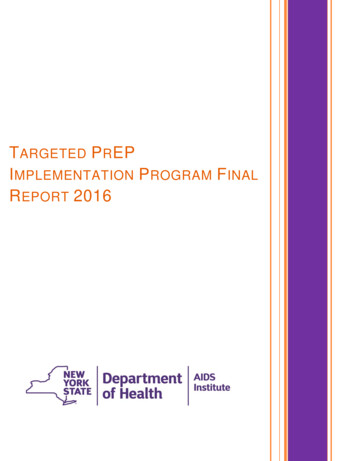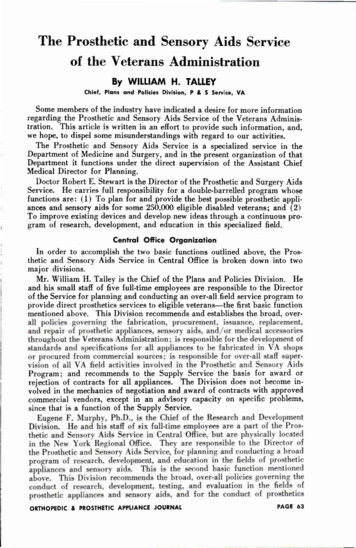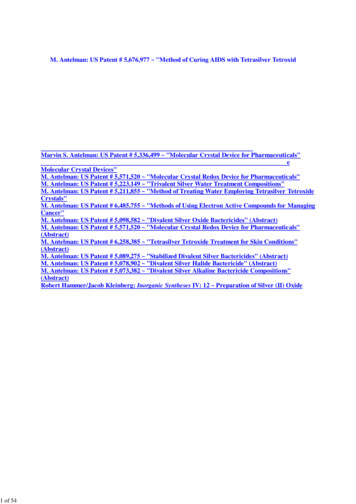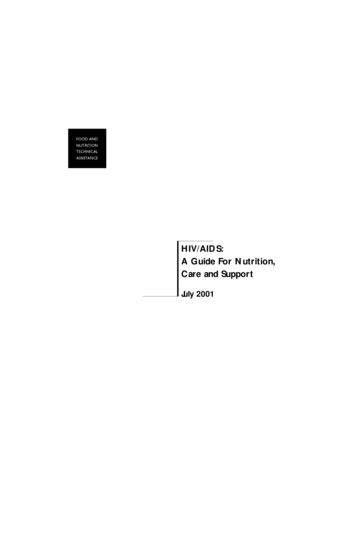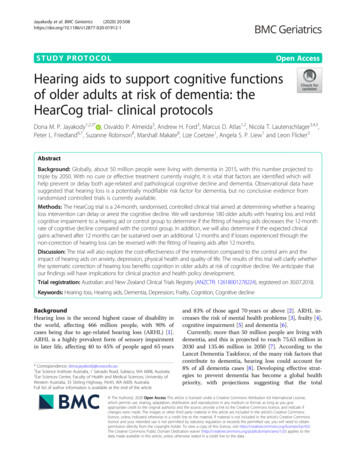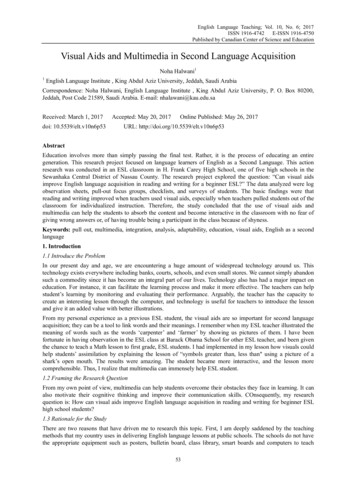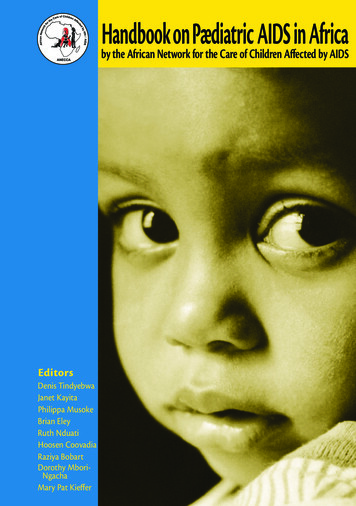
Transcription
Handbook on Pædiatric AIDS in Africaby the African Network for the Care of Children Affected by AIDSEditorsDenis TindyebwaJanet KayitaPhilippa MusokeBrian EleyRuth NduatiHoosen CoovadiaRaziya BobartDorothy MboriNgachaMary Pat Kieffer
2004 African Network for the Care of Children Affected by AIDS (ANECCA).All rights reserved. This book may be freely reviewed, quoted, reproduced, or translated, infull or in part, provided the source is acknowledged. This book may not be sold or used inconjunction with commercial purposes.
Handbook on Pædiatric AIDS in Africaby the African Network for the Care of Children Affected by AIDSEditorsDenis TindyebwaJanet KayitaPhilippa MusokeBrian EleyRuth NduatiHoosen CoovadiaRaziya BobartDorothy Mbori-NgachaMary Pat Kieffer
ContributorsGabriel Anabwani; MBChB; MMed (Paed); MSc; Clinical Professor of Paediatrics,Baylor College of Medicine; Director, Botswana-Baylor Children’s Centre of Excellence,Princess Marina Hospital, Gaborone, BotswanaAugustine Massawe; MD; MMed; Senior Lecturer, Consultant and Neonatologist,Muhimbili University College of Health Sciences and Muhimbili National Hospital,Dar es Salaam, TanzaniaPaul Bakaki; MBChB; MMed (Paed); Paediatrician/Investigator, Makerere University/John Hopkins University Research Collaboration, UgandaSabrina Bakera-Kitaka; MBChB; MMed (Paed); Paediatrician, Mulago Hospital,UgandaG. Bhat; MD; MRCP; Former Head of Department of Paediatrics, University TeachingHospital, Lusaka, ZambiaRaziya Bobart; MBChB; FC Paed; MD; Associate Professor/Principal Specialist, Department of Paediatrics & Child Health, Nelson Mandela School of Medicine, Universityof Kwazulu-Natal, South AfricaInam Chitsike; MBChB; MMed (Paed); MClin Epi; Regional Advisor PMTCT, Divisionof Family and Reproductive Health, WHO Africa Region, CongoHoosen Coovadia; Paediatrician; Victor Daitz Professor of HIV/AIDS Research andDirector of Centre for HIV/AIDS Networking (HIVAN), Nelson Mandela School ofMedicine University of Kwazulu-Natal, Durban, South AfricaBrian Eley; MBChB; BSc; FC Paed (SA); Senior Specialist and Senior Lecturer, Red CrossChildren’s Hospital and University of Cape Town, South AfricaLaura A. Guay; MD; Associate Professor of Pathology/Paediatrics, John HopkinsUniversity School of Medicine, USAIrene Inwani; MBChB; MMed (Paed); Consultant Paediatrician, Kenyatta NationalHospital, Nairobi, KenyaIsrael Kalyesubula; MBChB; MMed (Paed); DTCH; Consultant Paediatrician, MulagoHospital, UgandaJanet Kayita; MBChB; MMed (Paed); MPH; Regional Senior Technical Officer, Careand Treatment Division, Family Health International, KenyaMary Pat Kieffer; MSc; Senior Regional Technical Advisor on PMTCT and PaediatricAIDS, USAID/REDSO, KenyaLawrence Marum; MD; FAAP; MPH; Medical Epidemiologist and Paediatrician GlobalAIDS Program, Centers for Disease Control and Prevention, Kenya
Dorothy Mbori-Ngacha; MBChB; MMed (Paed); MPH; Senior Lecturer, Department ofPaediatrics, University of Nairobi, Kenya; Senior Technical Advisor, Centers for DiseaseControl and Prevention Global AIDS Program, KenyaPhilippe Msellati; MD; PhD; Epidemiologist and Director of the Institute of Research forDevelopment, Burkina FasoPeter Mugyenyi; MBChB; MRCP; Director, Joint Clinical Research Centre, Kampala,UgandaAngela Munyika Mushavi; MBChB, MMed (Paed); Consultant Paediatrician, HarareHospital, ZimbabwePhilippa Musoke; MBChB; FAAP; Senior Lecturer and Head of Department of Paediatrics and Child Health, Makerere University, UgandaRobert Mwadime; MPH; MSc; PhD; Nutritionist, FANTA/Regional Centre for Quality ofHealth Care, Makerere University, UgandaCharles Mwansambo; MBChB; BSc; DCH; MRCP; MRCPCH; Consultant Paediatrician,Kamuzu Central Hospital, Lilongwe, MalawiGrace Ndezi; MBChB; MMed (Paed); Senior Lecturer, Department of Paediatrics andChild Health, Makerere University, UgandaRuth Nduati; MBChB; MMed (Paed); MPH (Epid); Senior Lecturer, Department ofPaediatrics, University of Nairobi, KenyaNeema Rusibamaliya; MD; MMed (Paed); Paediatrician, Muhimbili National Hospital,Dar es Salaam, TanzaniaDeborah Nakiboneka Senabulya; MBChB; MMed (Paed); Paediatrician, Mulago Hospital, UgandaIsmail Ticklay; MSc, MBChB, MMed (Paed), Consultant Paediatrician, Harare Hospital;Honorary Lecturer, University of Zimbabwe, ZimbabweDenis Tindyebwa; MBChB; MMed (Paed); Senior Consultant Paediatrician, HIV/AIDSAdvisor, Regional Centre for Quality of Health Care, Makerere University, Uganda
AcknowledgmentsWe sincerely thank the office of USAID REDSO/ESA, based in Nairobi, Kenya, for agreeing to fundthe entire production of this handbook, including the many meetings the authors and editorsheld to put the chapters together. We are grateful to Family Health International for managing thecopyediting, design, and printing.USAID/REDSO funded this activity through the Regional Centre for Quality of Health Care(RCQHC) at Makerere University, to which we are also grateful.We also thank USAID/REDSO for funding the African Network for the Care of Children Affected byAIDS (ANECCA) in its broader efforts to improve the care of HIV-affected and -infected childrenin Africa.ANECCA is an informal network of health workers and social scientists committed to finding waysto improve care for HIV-exposed and -infected children in Africa. Members of the network identified the fact that while there are widespread knowledge gaps in the care of HIV-infected childrenin Africa, there are nonetheless scattered experiences across the continent that need to be shared.They thus volunteered their time to put together this book. It was a long and sometimes stressfulprocess. Because some issues concerning paediatric AIDS had no clear-cut international or nationalguidelines, network members had to reach consensus, sometimes through intense discussions. Ithank them for the mature and professional manner in which they held these discussions to reachthe consensus reflected in this handbook.As much as possible, and where they do exist, we have tried to remain within the available international guidelines from WHO or UNICEF, and these are acknowledged.ANECCA members who are authors of this handbook also form the core of their respectivenational committees on paediatric AIDS care, and some sections resemble what appears in theirnational guidelines. We therefore acknowledge these national guidelines and the individual authorswho provided us with the materials therein. Special mention goes to our colleagues in South Africa(Prof. H. Coovadia, Prof. Raziya Bobart, Dr. Brian Eley, and Dr. Tammy Meyers).We would also like to acknowledge comments received after the launch of the preliminary editionat the International AIDS Conference in Bangkok in July 2004. Special thanks go to Dr. Peter Salamaof the USAID Africa Bureau in Washington and Dr. Timothy Quick of the USAID Global HealthBureau, also in Washington.We would like to thank all of the enthusiastic readers who have sent in numerous requests for copies of the initial handbook and who, in the process, have expedited this final edition.Dr Denis TindyebwaChairpersonAfrican Network for the Care of Children Affected by AIDS (ANECCA)ANECCA SecretariatRegional Centre for Quality of Health CareP O Box 29140Kampala, UgandaTel 256-41-530888Fax 256-41-530876Email dtindyebwa@rcqhc.org or anecca@rcqhc.orgThe handbook will be available at the Regional Centre for Quality of Health Care Web site:www.rcqhc.org
Table of ContentsAcronyms and Abbreviations . . . . . . . . . . . . . . . . . . . . . . . . . . . . . . . . . . . . . . . . 5Chapter 1: Introduction . . . . . . . . . . . . . . . . . . . . . . . . . . . . . . . . . . . . . . . . . . . . 9Introduction . . . . . . . . . . . . . . . . . . . . . . . . . . . . . . . . . . . . 11Chapter 2: Epidemiology, Pathogenesis, and Natural History . . . . . . . . . . . . . . . . . . . 15Epidemiology . . . . . . . . . . . . . . . . . . . . . . . . . . . . . . . . . . . . 17HIV Virology and Pathogenesis . . . . . . . . . . . . . . . . . . . . . . . . . . . . 22Natural History . . . . . . . . . . . . . . . . . . . . . . . . . . . . . . . . . . . 29Chapter 3: Preventing Paediatric HIV Infection . . . . . . . . . . . . . . . . . . . . . . . . . . . . 33HIV Transmission Modes in Children . . . . . . .Preventing Paediatric HIV Infection . . . . . . .Preventing Other Modes of Horizontal TransmissionPost-Exposure Prophylaxsis for Healthcare Providers.35385051Chapter 4: Approach to Care of HIV-Exposed or HIV-Infected Child . . . . . . . . . . . . . . 53Interventions Common to Both HIV-Exposed and HIV-Infected Infants . . . . . . . . . . . 57Services Specific for HIV-Infected Children . . . . . . . . . . . . . . . . . . . . . . . 65Children Whose Parents/Guardians Have AIDS or Who Are Orphaned by AIDS . . . . . . . 69Chapter 5: Diagnosis and Clinical Staging of HIV Infection . . . . . . . . . . . . . . . . . . . . . 73Why Is It Important to Make a Diagnosis of HIV Infection?Laboratory Assays (Tests) . . . . . . . . . . . . . . .Virologic Tests . . . . . . . . . . . . . . . . . . .Staging HIV Infection and Disease in Children . . . . . .75798083Chapter 6: Common Clinical Conditions Associated with HIV . . . . . . . . . . . . . . . . . . 91Diarrhoea . . . . . . . . . . . . . . .Malnutrition . . . . . . . . . . . . .Neurological Manifestations . . . . . . .Other Neurological Manifestations . . . .Dermatitis and Other Skin Manifestations .Oral and Dental Conditions . . . . . . .Malignancy . . . . . . . . . . . . . .Parotid Enlargement . . . . . . . . . .Persistent Generalised Lymphadenopathy .Other Medical Conditions . . . . . . . 93. 96.102.104.107.109.110.110.111.111Chapter 7: Pulmonary Conditions . . . . . . . . . . . . . . . . . . . . . . . . . . . . . . . . . . . .115Bacterial Pneumonia . . . . .Managing Bacterial PneumoniaManaging Severe Pneumonia .Pneumocystis Pneumonia . . .117.119.119.121Handbook on Pædiatric AIDS in Africa
Chronic Lung Disease . . . . .Tuberculosis . . . . . . . . . .Drug/Drug Interactions . . . .Lymphoid Interstitial PneumonitisBronchiectasis . . . . . . . . .Viral Pneumonitis . . . . . . .Other Pulmonary Conditions . .124.124.129.129.131.132.133Chapter 8: Antiretroviral Therapy . . . . . . . . . . . . . . . . . . . . . . . . . . . . . . . . . . . . .135Principles of ART . . . . . . . . . . . . . . .ART for Children . . . . . . . . . . . . . . . .Organisational Issues . . . . . . . . . . . . . .Opportunities and Entry Points for ART in ChildrenRequirements Before Treatment Is Started . . . . .Pre-Treatment Assessment . . . . . . . . . . .First-Line Therapy . . . . . . . . . . . . . . .Monitoring and Follow-Up . . . . . . . . . . .Antiretroviral Therapy and TB Treatment . . . . .Indications for Changing Therapy . . . . . . . .Second-Line Therapy . . . . . . . . . . . . . r 9: Adolescent Issues . . . . . . . . . . . . . . . . . . . . . . . . . . . . . . . . . . . . . . . .159Adolescents Requiring HIV-Related Services . . . . .Risk Factors for HIV Infection Among Adolescents . .HIV Preventive Services for Youth . . . . . . . . .Services for HIV-Infected Youth . . . . . . . . . .Support for Youth-Friendly Policies and Programmes .163.163.165.167.174Chapter 10: Long-Term and Terminal Care Planning for Children Affected by HIV/AIDS andTheir Families . . . . . . . . . . . . . . . . . . . . . . . . . . . . . . . . . . . . . . . . . . . . . . . . .177Is Chronic Disease Management Relevant to Children Infected with HIV?What Is the Starting Point for Planning Long-Term Care? . . . . . . .Needs of the Well Child . . . . . . . . . . . . . . . . . . . . .Needs of the Sick Child . . . . . . . . . . . . . . . . . . . . .Needs of the Terminally Ill Child . . . . . . . . . . . . . . . . . .Symptom Relief . . . . . . . . . . . . . . . . . . . . . . . . .Pain Management . . . . . . . . . . . . . . . . . . . . . . . .Child with Terminally Ill Parents . . . . . . . . . . . . . . . . . .Requirements to Ensure that Long-Term Care Is Planned and Executed .179.180.181.182.183.185.188.192.194Chapter 11: Counselling and Psychosocial Support . . . . . . . . . . . . . . . . . . . . . . . . .199Periods of Psychosocial Vulnerability . . . . . . . . . . . . . . . . . . . . . . . . . .202Issues to Address in Psychosocial Support for Children Affected by HIV/AIDS . . . . . . . .2032 Handbook on Pædiatric AIDS in Africa
Psychosocial Needs of Children . . . . . . . . . . . .Problems that Can Occur in Infected or Affected ChildrenCommunicating with Children . . . . . . . . . . . .HIV Testing for Children . . . . . . . . . . . . . . .Counselling and Disclosure . . . . . . . . . . . . . .Steps for Counselling HIV-Infected Children . . . . . . .205.205.205.207.207.211Chapter 12: Nutrition and HIV. . . . . . . . . . . . . . . . . . . . . . . . . . . . . . . . . . . . . . .213Nutrition Management . . . . . . . . . . . . . . . . . . .Prevent or Mitigate Factors Associated with Risk of Malnutrition .Infant Feeding Practices in the Context of HIV . . . . . . . . .Periodic Nutrition Assessment and Growth Monitoring . . . . .Provide Nutritional Supplementation and Rehabilitation . . . .Preserving Lean Body Mass . . . . . . . . . . . . . . . . .Additional Strategies . . . . . . . . . . . . . . . . . . . .215.216.217.222.223.229.229Appendices . . . . . . . . . . . . . . . . . . . . . . . . . . . . . . . . . . . . . . . . . . . . . . . . . . .231Appendix A: Clinical Situations and Recommendations for the Use of Antiretroviral Drugs inPregnant Women and Women of Child-Bearing Potential in Resource-Constrained Settings .Appendix B: CDC 1994 Revised Human Immunodeficiency VirusPaediatric Classification System: Clinical Categories . . . . . . . . . . . . . . . . . . .Appendix C: Sexual Maturity Rating . . . . . . . . . . . . . . . . . . . . . . . . .Appendix D: Safe Infant Feeding . . . . . . . . . . . . . . . . . . . . . . . . . . .Appendix E: Grading of Adverse Events . . . . . . . . . . . . . . . . . . . . . . . .233.237.241.243.250Tables and FiguresFigure 2.1. Median HIV Prevalence (%) in Antenatal Clinics in Urban Areas,by Sub-Region, in Sub-Saharan Africa, 1990 2002 . . . . . . . . . . . . . . . . . . . . 18Figure 2.2. Estimated Impact of AIDS on Under-Five Child Mortality Rates,Selected African Countries . . . . . . . . . . . . . . . . . . . . . . . . . . . . . . 19Figure 2.3. Infant Mortality Rates in HIV-Exposed and Unexposed Babies: Datafrom 5 Different Cohort Studies . . . . . . . . . . . . . . . . . . . . . . . . . . . . 20Figure 2.4. Estimated Prevalence of HIV-1 env Subtypes by Region (2000) . . . . . . . . . . 23Figure 2.5. HIV Structure . . . . . . . . . . . . . . . . . . . . . . . . . . . . . . . 25Figure 2.6. HIV Replication Cycle . . . . . . . . . . . . . . . . . . . . . . . . . . . 26Table 2.1. Immunologic Classification for HIV-Infected Infants and Children . . . . . . . . . 28Table 3.1. Estimated Timing of Transmission and Absolute Transmission Rates . . . . . . . . 35Table 3.2. Risk Factors and Mitigating Interventions . . . . . . . . . . . . . . . . . . . 37Figure 3.1. Four-Pronged Approach to Paediatric HIV Infection (UN/WHO) . . . . . . . . . 38Table 3.3. Early MTCT Rates in Breast-Feeding Populations Where WomenReceived Antepartum and/or Intrapartum and/or Postpartum Regimens . . . . . . . . . . 42Handbook on Pædiatric AIDS in Africa 3
Figure 3.2. PMTCT Cascade: Women Attending ANC . . . . . . . . . . . . . . . . . . 46Figure 3.3. HIV-Infected Women Accessing Services . . . . . . . . . . . . . . . . . . . 47Table 3.4. Drug Dosage for Post-Exposure Prophylaxis . . . . . . . . . . . . . . . . . . 49Table 4.1. Who Needs PCP Prophylaxis? . . . . . . . . . . . . . . . . . . . . . . . . 62Table 4.2. Dose of Cotrimoxazole for PCP Prophylaxis . . . . . . . . . . . . . . . . . . 62Table 4.3. WHO Recommendations for Follow-up of an HIV-Exposed Child . . . . . . . . . 64Table 5.1. Clinical Signs or Conditions in Child That May Suggest HIV Infection . . . . . . . 78Table 5.2. WHO Paediatric Staging of HIV/AIDS Disease . . . . . . . . . . . . . . . . . 85Table 5.3. 1986 WHO Case Definition of AIDS in Children . . . . . . . . . . . . . . . . 87Table 5.4. Immunological Classification Based on Total and % CD4 Count . . . . . . . . . 88Table 5.5. What Can Be Done for Different Levels of Resources and Certainty of Diagnosis? . . 89Table 6.1. Opportunistic Infections of the Central Nervous System . . . . . . . . . . . . .106Table 6.2. Common Skin Manifestations and Treatments . . . . . . . . . . . . . . . . .108Figure 7.1. Threat of PCP: AIDS-Defining Conditions by Age at DiagnosisPerinatally-Acquired AIDS Cases through 1992, USA . . . . . . . . . . . . . . . . . . .122Table 7.1. Evaluation of HIV-Exposed Infant for Tuberculosis Disease . . . . . . . . . . . .125Table 7.2. Impact of HIV Infection on Value of Commonly Used Criteria for Diagnosis of TB. .126Table 7.3. Treatment/Prophylaxis of TB in HIV-Exposed or HIV-Infected Infants . . . . . . .128Table 7.4. Comparison of Miliary TB and LIP . . . . . . . . . . . . . . . . . . . . . .130Table 8.1. Specific Issues to Consider When Treating HIV-Infected Children with ART . . . .139Table 8.1. WHO Recommendations for ART in Children When CD4 Testing Is Available: . . .143Table 8.2. Antiretroviral Drugs in Paediatric Practice . . . . . . . . . . . . . . . . . . .145Table 8.3. Clinical Signs, Symptoms, Monitoring, and Managementof Symptoms of Serious Adverse Effects of ART that Require Drug Discontinuation . . . . . .154Table 9.1. Adolescent Development . . . . . . . . . . . . . . . . . . . . . . . . . .162Table 10.1. Other Common Symptoms, Causes, and Their Management . . . . . . . . . .187Table 10.2. Children’s Perceptions of Death and Possible Interventions . . . . . . . . . . .193Figure 10.2. Long-Term Care Planning for Children with HIV . . . . . . . . . . . . . . .196Table 11.1. Psychosocial Assessment of Anticipated Family Adaptation . . . . . . . . . . .202Figure 12.1. Weight-for-Age Before and After Onset of ARV Therapy . . . . . . . . . . . .223Table 12.1. Strategies to Prevent and Treat Malnutrition in HIV-Exposedand HIV-Infected Children . . . . . . . . . . . . . . . . . . . . . . . . . . . . . .225Table 12.2. Nutritional Management for Children With and Without Evidenceof Malnutrition . . . . . . . . . . . . . . . . . . . . . . . . . . . . . . . . . . .2284 Handbook on Pædiatric AIDS in Africa
Acronyms and Abbreviations3TC . . . . . . . . . . . . . . . . . . . . . . . . . . . . . . . . . . . . . LamivudineABC . . . . . . . . . . . . . . . . . . . . . . . . . . . . . . . . . . . . . . AbacavirAIDS . . . . . . . . . . . . . . . . . . . . . . . Acquired Immune Deficiency SyndromeANC . . . . . . . . . . . . . . . . . . . . . . . . . . . . . . . . . . Antenatal CareART . . . . . . . . . . . . . . . . . . . . . . . . . . . . . . . . Antiretroviral TherapyARV. . . . . . . . . . . . . . . . . . . . . . . . . . . . . . . . . Antiretroviral DrugsAZT . . . . . . . . . . . . . . . . . . . . . . . . . . . . . . . . . . . . ZidovudineBCC . . . . . . . . . . . . . . . . . . . . . . . . . .Behaviour Change CommunicationCBC. . . . . . . . . . . . . . . . . . . . . . . . . . . . . . . . Complete Blood CountCDC . . . . . . . . . . . . . . . . United States Centers for Disease Control and PreventionCFR . . . . . . . . . . . . . . . . . . . . . . . . . . . . . . . . . . Case Fatality RateCSF . . . . . . . . . . . . . . . . . . . . . . . . . . . . . . . . . . Cerebrospinal FluidCMV . . . . . . . . . . . . . . . . . . . . . . . . . . . . . . . . . . CytomegalovirusCNS. . . . . . . . . . . . . . . . . . . . . . . . . . . . . . . .Central Nervous SystemCRC. . . . . . . . . . . . . . . . . . United Nations Convention on the Rights of ChildrenCT . . . . . . . . . . . . . . . . . . . . . . . . . . . . . . Computerized TomographyCTZ. . . . . . . . . . . . . . . . . . . . . . . . . . . . . . . . . . . . Cotrimoxazoled4T . . . . . . . . . . . . . . . . . . . . . . . . . . . . . . . . . . . . . . StavudineddI . . . . . . . . . . . . . . . . . . . . . . . . . . . . . . . . . . . . . DidanosineDNA . . . . . . . . . . . . . . . . . . . . . . . . . . . . . . . Deoxyribonucleic AcidDOT . . . . . . . . . . . . . . . . . . . . . . . . . . . . . Directly Observed TherapyEBV . . . . . . . . . . . . . . . . . . . . . . . . . . . . . . . . . . Epstein Barr VirusEEG . . . . . . . . . . . . . . . . . . . . . . . . . . . . . . . . ElectroencephalographEFV . . . . . . . . . . . . . . . . . . . . . . . . . . . . . . . . . . . . . . EfavirenzELISA . . . . . . . . . . . . . . . . . . . . . . . . Enzyme-Linked Immunosorbent AssayEPI . . . . . . . . . . . . . . . . . . . . . . . . Expanded Programmes on ImmunisationFHI . . . . . . . . . . . . . . . . . . . . . . . . . . . . . . Family Health Internationalgp . . . . . . . . . . . . . . . . . . . . . . . . . . . . . . . . . . . . GlycoproteinHAART . . . . . . . . . . . . . . . . . . . . . . . . Highly Active Antiretroviral TherapyHIV . . . . . . . . . . . . . . . . . . . . . . . . . . . . Human Immunodeficiency VirusHPV . . . . . . . . . . . . . . . . . . . . . . . . . . . . . . . Human PapillomavirusHRSA . . . . . . . . . . . . . . . . . . . . . Health Resources and Services AdministrationHSV. . . . . . . . . . . . . . . . . . . . . . . . . . . . . . . . . Herpes Simplex VirusIDU . . . . . . . . . . . . . . . . . . . . . . . . . . . . . . . . . .Injecting Drug UserHandbook on Pædiatric AIDS in Africa 5
IMCI . . . . . . . . . . . . . . . . . . . . Integrated Management of Childhood IllnessesI/O . . . . . . . . . . . . . . . . . . . . . . . . . . . . . . . . . . Input and OutputIU . . . . . . . . . . . . . . . . . . . . . . . . . . . . . . . . . . International UnitsIPT . . . . . . . . . . . . . . . . . . . . . . . . . . . Intermittent Preventative TherapyIRIS . . . . . . . . . . . . . . . . . . . . Immune Reconstitution Inflammatory SyndromeKS . . . . . . . . . . . . . . . . . . . . . . . . . . . . . . . . . . .Kaposi’s SarcomaLBM . . . . . . . . . . . . . . . . . . . . . . . . . . . . . . . . . . Lean Body MassLBW . . . . . . . . . . . . . . . . . . . . . . . . . . . . . . . . . Low Birth WeightLIP . . . . . . . . . . . . . . . . . . . . . . . . . . . Lymphoid Interstitial PneumonitisLPV/RTV . . . . . . . . . . . . . . . . . . . . . . . . . . . . . . . Lopinavir/RitonavirLRTI. . . . . . . . . . . . . . . . . . . . . . . . . . . Lower Respiratory Tract InfectionMCH . . . . . . . . . . . . . . . . . . . . . . . . . . . . . Maternal and Child HealthMRI . . . . . . . . . . . . . . . . . . . . . . . . . . . . . Magnetic Resonance ImagingMTB . . . . . . . . . . . . . . . . . . . . . . . . . . . . Mycobacterium TuberculosisMTCT . . . . . . . . . . . . . . . . . . . . . . . . . . . . Mother-to-Child Transmissionmths . . . . . . . . . . . . . . . . . . . . . . . . . . . . . . . . . . . . . . MonthsMUAC . . . . . . . . . . . . . . . . . . . . . . . . . . Mid-Upper-Arm CircumferenceNASBA . . . . . . . . . . . . . . . . . . . . . Nucleic Acid Sequence-Based AmplificationNCHS . . . . . . . . . . . . . . . . . . . . . . . . . National Center for Health StatisticsNFV. . . . . . . . . . . . . . . . . . . . . . . . . . . . . . . . . . . . . . NelfinavirNNRTI . . . . . . . . . . . . . . . . . . . Non-Nucleoside Reverse Transcriptase InhibitorsNRTI . . . . . . . . . . . . . . . . . . . . . . Nucleoside Reverse Transcriptase InhibitorsNSI . . . . . . . . . . . . . . . . . . . . . . . . . . . . . . . Non-Syncitium InducingNVP . . . . . . . . . . . . . . . . . . . . . . . . . . . . . . . . . . . . NevirapineOI . . . . . . . . . . . . . . . . . . . . . . . . . . . . . . . . Opportunistic InfectionOVC . . . . . . . . . . . . . . . . . . . . . . . . . . Orphans and Vulnerable ChildrenPACTG . . . . . . . . . . . . . . . . . . . . . . . . . Pediatric AIDS Clinical Trials GroupPCP . . . . . . . . . . . . . . . . . . . . . . . . . . . . . . . Pneumocystis PneumoniaPCR . . . . . . . . . . . . . . . . . . . . . . . . . . . . . . Polymerase Chain ReactionPEP . . . . . . . . . . . . . . . . . . . . . . . . . . . . . . . Post-Exposure ProphylaxisPGL . . . . . . . . . . . . . . . . . . . . . . . . Persistent Generalized LymphadenopathyPI . . . . . . . . . . . . . . . . . . . . . . . . . . . . . . . . . . . Protease InhibitorPLHA . . . . . . . . . . . . . . . . . . . . . . . . . . . . People Living with HIV/AIDSPML . . . . . . . . . . . . . . . . . . . . . Progressive Multifocal LeukoencephalopathyPMTCT . . . . . . . . . . . . . . . . . . . . .Prevention of Mother-to-Child Transmission6 Handbook on Pædiatric AIDS in Africa
RNA . . . . . . . . . . . . . . . . . . . . . . . . . . . . . . . . . .Ribonucleic AcidRSV . . . . . . . . . . . . . . . . . . . . . . . . . . . . . . Respiratory Syncytial VirusRT . . . . . . . . . . . . . . . . . . . . . . . . . . . . . . . . . Reverse TranscriptaseRTV . . . . . . . . . . . . . . . . . . . . . . . . . . . . . . . . . . . . . . RitonavirRV . . . . . . . . . . . . . . . . . . . . . . . . . . . . . . . . . . . . . . RotavirusSFT . . . . . . . . . . . . . . . . . . . . . . . . . . . . . . . . . Skin-Fold ThicknessSMX . . . . . . . . . . . . . . . . . . . . . . . . . . . . . . . . . SulfamethoxazoleSSA . . . . . . . . . . . . . . . . . . . . . . . . . . . . . . . . . . Sub-Saharan AfricaSTI . . . . . . . . . . . . . . . . . . . . . . . . . . . . . Sexually Transmitted InfectionTB . . . . . . . . . . . . . . . . . . . . . . . . . . . . . . . . . . . . . TuberculosisTLC . . . . . . . . . . . . . . . . . . . . . . . . . . . . . . . Total Lymphocyte CountTMP . . . . . . . . . . . . . . . . . . . . . . . . . . . . . . . . . . . TrimethoprimUNAIDS . . . . . . . . . . . . . . . . . . . .United Nations Joint Programme on HIV/AIDSUNFPA . . . . . . . . . . . . . . . . . . . . . . . . . . United Nations Population FundUNFPA . . . . . . . . . . . . . . . . . . . . . . . . . . United Nations Children’s FundURI . . . . . . . . . . . . . . . . . . . . . . . . . . . . . . Upper Respiratory InfectionUSAID . . . . . . . . . . . . . . . . . United States Agency for International DevelopmentVCT . . . . . . . . . . . . . . . . . . . . . . . . . . Voluntary Counselling and TestingVZIG . . . . . . . . . . . . . . . . . . . . . . . . . . Varicella-Zoster Immune GlobulinWBC . . . . . . . . . . . . . . . . . . . . . . . . . . . . . . . . White Blood CountWHO . . . . . . . . . . . . . . . . . . . . . . . . . . . . . World Health Organizationwk . . . . . . . . . . . . . . . . . . . . . . . . . . . . . . . . . . . . . . . . Weekwks . . . . . . . . . . . . . . . . . . . . . . . . . . . . . . . . . . . . . . . WeeksZDV . . . . . . . . . . . . . . . . . . . . . . . . . . . . . . . . . . . . ZidovudineHandbook on Pædiatric AIDS in Africa 7
8 Handbook on Pædiatric AIDS in Africa
Chapter 1IntroductionHandbook on Pædiatric AIDS in Africa 9
10 Handbook on Pædiatric AIDS in Africa
IntroductionHIV/AIDS is a major cause of infant and childhood mortality andmorbidity in Africa. In children under five years of age, HIV/AIDSnow accounts for 7.7% of mortality worldwide. AIDS already accountsfor a rise of more than 19% in infant mortality and a 36% rise in underfive mortality. Together with factors such as declining immunisation,HIV/AIDS is threatening recent gains in infant and child survival andhealth.Yet, for the most part, HIV infection in children is preventable. Inindustrialised countries in North America and Europe, paediatric HIVinfection has largely been controlled. In these settings, HIV testing aspart of routine antenatal care, combinations of antiretroviral (ARV)drug regimens, elective caesarean section, and complete avoidanceof breast-feeding have translated into mother-to-child transmission(MTCT) rates of less than 2%.In Africa, on the other hand, high rates of maternal HIV infection,high birth rates, lack of access to currently available and feasible interventions, and the widespread practice of prolonged breast-feedingtranslate into a high burden of paediatric HIV disease. The transmission risk for a child born to an HIV-infected mother in an Africansetting without interventions for prevention of mother-to-child transmission (PMTCT) is about 30–40%. The other 60–70% of children,although not HIV-infected, still have a 2- to 5-fold risk of mortality asa direct consequence of the mother’s HIV disease, when compared tochildren born to uninfected mothers.Efforts to expand care and treatment for children must go hand inhand with efforts to rapidly improve the uptake of available interventions for reducing MTCT. Currently these reach less than 10% of thepopulation in the countries that are most affected. Access to currentlyavailable, effective care and treatment remains
the entire production of this handbook, including the many meetings the authors and editors held to put the chapters together. We are
